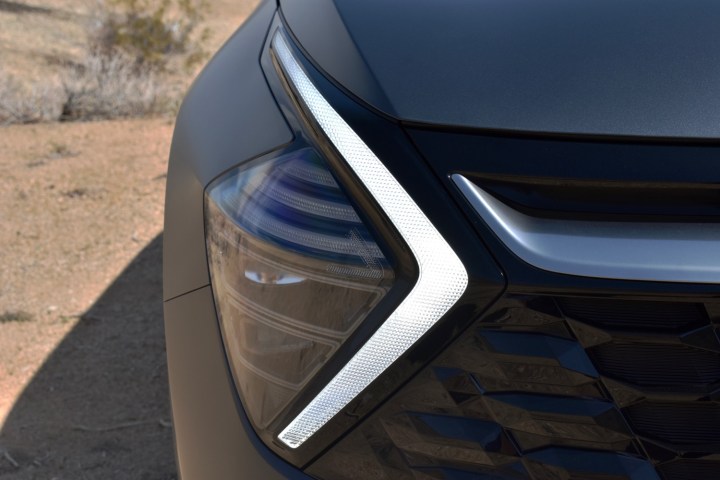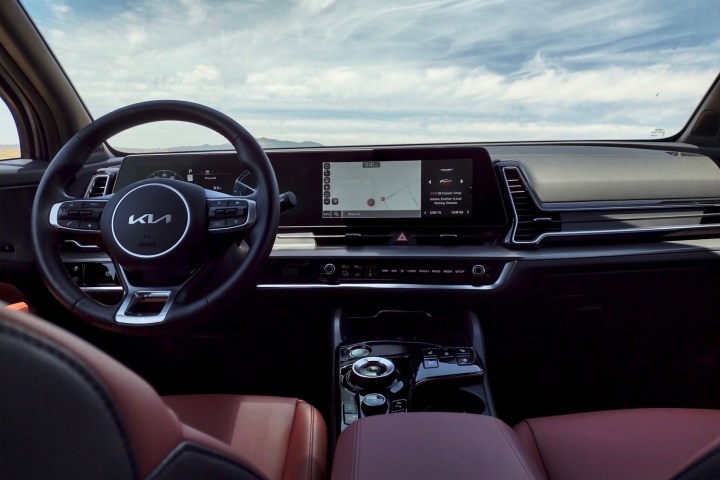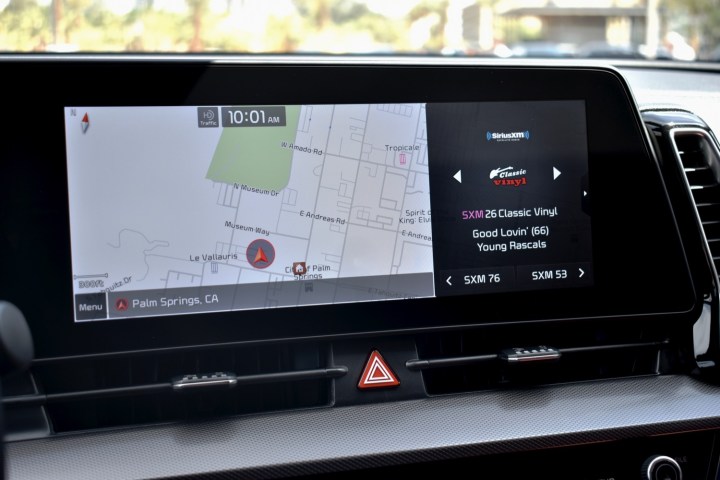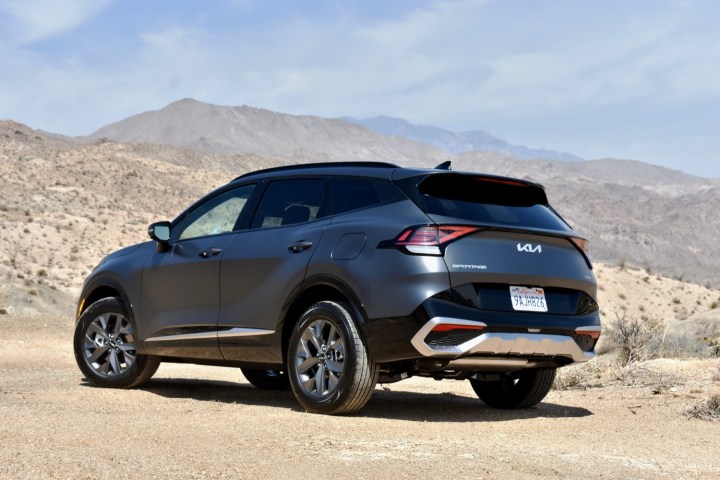Looking at its current lineup, it’s hard to believe Kia was once a byword for cheapness. In fact, the only nameplate remaining from those bad old days is the Kia Sportage. Since its launch in 1993, the Sportage has evolved from a curiosity to a true mainstream crossover SUV. But it was still missing something.
The previous-generation Sportage was a solid contender, but with some many vehicles to choose from in this crowded market segment, Kia needed to do more to stand out. To that end, the redesigned 2023 Kia Sportage adds a first-ever hybrid powertrain. Kia is fairly late to the hybrid crossover game, however, as hybrid versions of the Ford Escape, Honda CR-V, and Toyota RAV4 have already been on sale for some time, while Kia parent Hyundai launched its Tucson Hybrid for the 2022 model year.
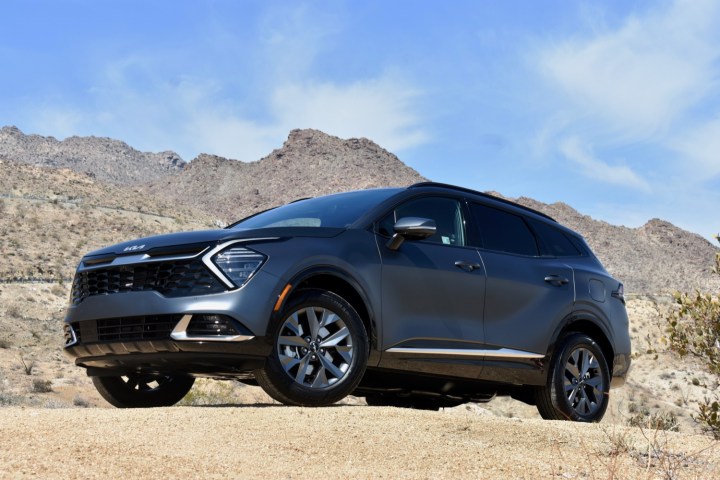
The 2023 Kia Sportage Hybrid launches in LX, EX, and SX-Prestige trim levels. Pricing starts at $28,545 for a base front-wheel drive LX model — a $1,300 premium over the non-hybrid model. The mid-level EX and top SX-Prestige trim levels get standard all-wheel drive, and start at $32,245 and $37,445, respectively. Our test car was an SX-Prestige model with the more expensive Shadow Matte Gray paint and a Carmine Red interior, which brought the as-tested price to $38,155.
Built in Gwangju, South Korea, the Sportage Hybrid will hit dealerships later this year. A plug-in hybrid version is on the way as well.
Design and interior
It’s easy to spot a 2023 Sportage thanks to a radical new front fascia with blade-like LED daytime running lights encapsulating triangular headlights. The way the lights blend into the grille gives the Sportage a somewhat alien appearance. The rest of the exterior styling is fairly conventional, however, which means anyone approaching this car from behind is in for a shock when they see that front end. Regardless, it’s good to see Kia taking some aesthetic risks, especially in a market segment that doesn’t usually emphasize style.
The 2023 Sportage is based on the same N3 platform as the Kia Sorento. The redesign increased size in all dimensions, but particularly length. The new Sportage is about an inch taller and half an inch wider than the previous-generation model, but 7.1 inches longer. That includes a 3.4-inch longer wheelbase, which generally pays dividends in passenger space. The hybrid model has slightly less headroom and cargo space than the non-hybrid Sportage.
Anyone approaching this car from behind is in for a shock.
The Sportage Hybrid is also closely related to the Hyundai Tucson Hybrid, meaning their interior dimensions are virtually identical. The pair of two-row, five-seat Korean models are also fairly close to rival vehicles in headroom and legroom across both rows, showing just how competitive this market segment is.
Unlike its Hyundai sibling, however, the Sportage gets a dual-level cargo floor. At its lower height, it creates 39.5 cubic feet of cargo space with the rear seats in place. That’s more than the Hyundai — and all other similarly sized hybrid crossovers. The Sportage hybrid’s maximum 73.7 cubic feet of cargo space with the rear seats folded is slightly behind the Tucson hybrid, but still ahead of hybrid versions of the Ford Escape, Honda CR-V, and Toyota RAV4.
Our SX-Prestige test car had SynTex artificial leather, which Kia is now promoting as a sustainable design feature because it’s animal-free. However, it’s still the same fake leather Kia and other automakers have been using for years to save costs, and it feels that way. You’ll never mistake this for real leather upholstery. Other interior materials were fairly good for a mainstream vehicle, though.
Tech, infotainment, and driver assist
All 2023 Sportage models benefit from a major infotainment upgrade. Kia now offers a 12.3-inch digital instrument cluster and 12.3-inch touchscreen placed side by side to make one long curved display, something previously seen on only on luxury cars from BMW and Mercedes-Benz. However, that setup is only available on the top SX-Prestige model. The LX and EX models get 8.0-inch and 12.3-inch touchscreens, respectively, with a stand-alone instrument cluster. A touch-control panel sits below the main touchscreen, and can switch between audio and climate controls depending on which function is needed.
Wireless Apple CarPlay and Android Auto are available, but only with the smaller touchscreen. As with other Kia models, upgrading to the larger screen means downgrading to wired Apple CarPlay and Android Auto. A built-in 4G LTE Wi-Fi hot spot can support up to five devices, and four USB-C ports are standard. Higher trim levels add two rear USB-C ports, wireless phone charging, and a Harman Kardon audio system.
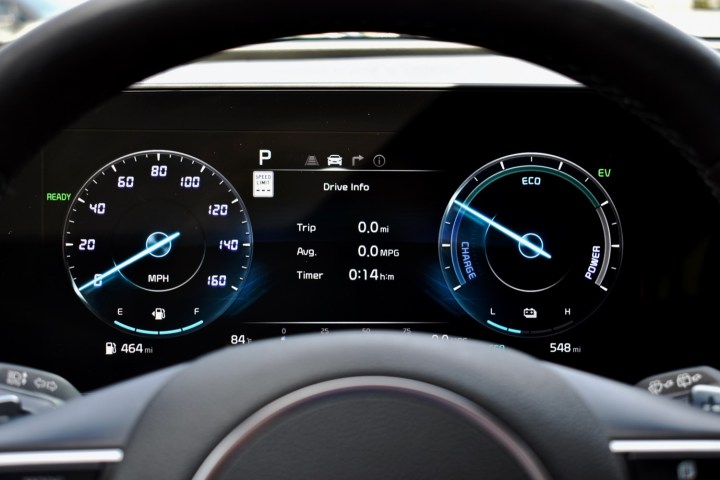
Our SX-Prestige test car had the top-of-the-line curved display, and it looked pretty slick. We also found the touchscreen to be pretty responsive, and liked the graphics, including a digital clock-style typeface for the speedometer. However, Android Auto won’t display across the entire touchscreen, and you have to switch to the Sport driving mode to get a tachometer reading in the instrument cluster. Those are fairly minor quibbles with an overall well-executed infotainment system, however.
Standard driver-assist features include forward collision warning (with vehicle, pedestrian, and cyclist detection), lane-keep assist, lane-departure warning, automatic high beams, and a driver-attention monitor. The EX model adds blind-spot collision avoidance assist and safe-exit warning, while the SX-Prestige adds adaptive cruise control (with stop-and-go functionality), Remote Smart Parking Assist, a 360-degree camera system, blind-spot-view camera, and Highway Driving Assist, which adds automated lane centering to the adaptive cruise control.
Driving experience
The Sportage Hybrid’s powertrain consists of a 1.6-liter turbocharged four-cylinder engine and six-speed automatic transmission assisted by a single electric motor. Total system output is 227 horsepower and 258 pound-feet of torque. The base LX model gets standard front-wheel drive and optional all-wheel drive, while the EX and SX-Prestige are all-wheel drive only.
This is essentially the same powertrain used in the Hyundai Tucson Hybrid, but the Kia makes an extra 1 hp. Both Korean models offer more horsepower than the 200-hp Ford Escape Hybrid, 212-hp Honda CR-V Hybrid, and 219-hp Toyota RAV4 Hybrid, but those manufactures don’t quote torque outputs for their hybrids.
Compared to its rivals, the Sportage Hybrid also drives more like a non-hybrid car. The blend of gasoline and electric power was seamless, and the six-speed automatic transmission provided quick shifts. That made for a linear application of power unlike other hybrid systems. And while small turbocharged engines can be caught out when their turbos aren’t up to speed, we had no issues with this one.
Compared to its rivals, the Sportage Hybrid drives more like a non-hybrid car.
This powertrain isn’t just good for a hybrid vehicle. We actually think the hybrid is nicer to drive than the non-hybrid Sportage. That version only gets 187 hp and a slow-shifting transmission.
While it is more powerful and responsive than rivals, the Sportage wasn’t designed for performance. Beyond the powertrain, its best attributes are a remarkably quiet interior and comfortable ride. The suspension kept the car composed and occupants in place during cornering, but it didn’t encourage us to attack each corner. The steering was unremarkable, and had an off-putting artificial heft in Sport mode.
Enthusiastic driving is not what this car is about, though. It’s just an ordinary crossover designed for everyday transportation. While some crossovers will try to humor driving enthusiasts, the Sportage doesn’t pretend to be something it’s not.
Gas mileage and safety
The Sportage Hybrid is rated at an unrivalled 43 mpg combined (42 mpg city, 44 mpg highway), but that’s only with front-wheel drive. All-wheel drive models are rated at 38 mpg in all three categories, erasing the Kia’s fuel-economy advantage. The all-wheel drive Ford Escape Hybrid and Toyota RAV4 Hybrid are rated at 40 mpg combined, while the Honda CR-V Hybrid matches the Kia at 38 mpg combined.
Crash-test ratings from the Insurance Institute for Highway Safety (IIHS) and National Highway Traffic Safety Administration (NHTSA) were not available at the time of publication. That’s because the Sportage Hybrid is a new model that only went on sale recently.
Like other Kia and Hyundai models, the Sportage Hybrid gets a 10-year, 100,000-mile powertrain warranty and five-year, 60,000-mile limited warranty that outclass other automakers’ coverage.
How DT would configure this car
If tech is the priority, the top SX-Prestige model is the obvious choice. The SX-Prestige gets the most standard driver-assist tech, including the Highway Driving Assist and Remote Smart Parking Assist systems. It also gets the dashboard-spanning curved display, which is the Sportage’s standout tech feature, in our opinion. Getting these features means paying a significant premium over the base Sportage Hybrid LX, but nearly every automaker requires customers to pay extra for maximum tech.
Our take
The 2023 Kia Sportage Hybrid delivers exactly what it needed. It’s competitive with hybrid versions of the Honda CR-V, Ford Escape, and Toyota RAV4 in the all-important fuel economy category, but offers more horsepower and better drivability. While the Kia’s Hyundai Tucson Hybrid cousin offers essentially the same powertrain, it doesn’t have the same curved display.
The Sportage Hybrid is also a good crossover SUV, offering similar interior space to other vehicles in its segment. Kia is no longer trying to undercut competitors in price, the Sportage Hybrid’s pricing is close to other hybrid crossovers.
No vehicle is perfect for everyone. While Kia’s decisions were understandable, we wish the Sportage Hybrid was a little more entertaining to drive. The styling may not be for everyone, either. But the Sportage Hybrid ticks all of the boxes that really matter, showing Kia’s often overlooked strength in hybrid vehicles.
Should you get one?
Yes. The Sportage may be new to the hybrid game, but it’s a strong contender out of the gate.
